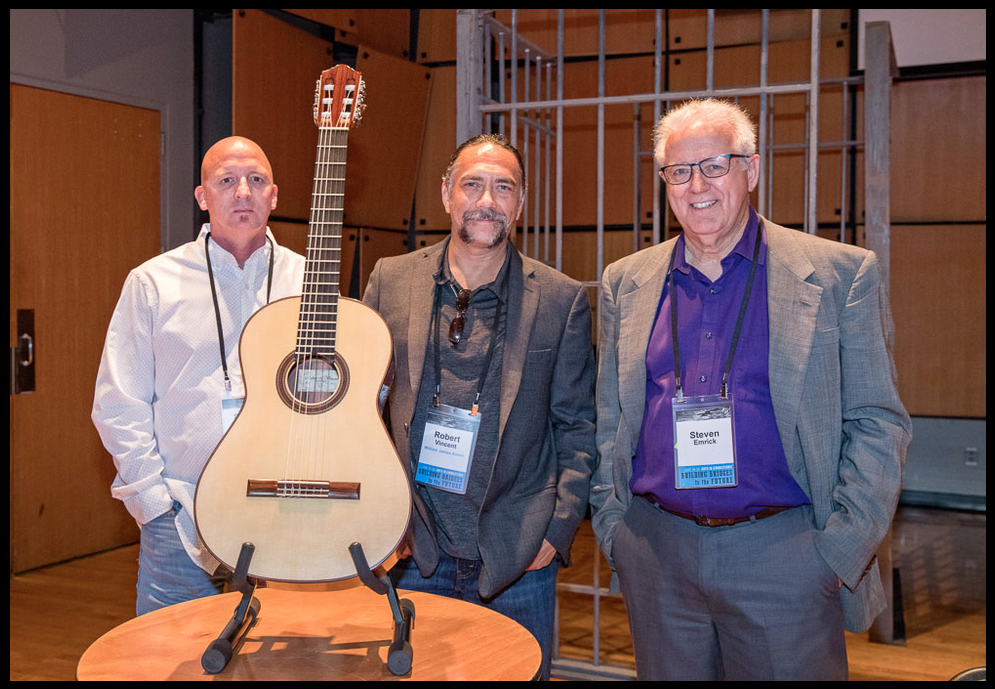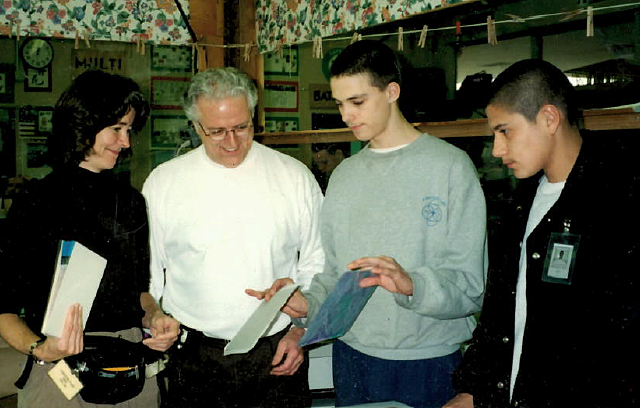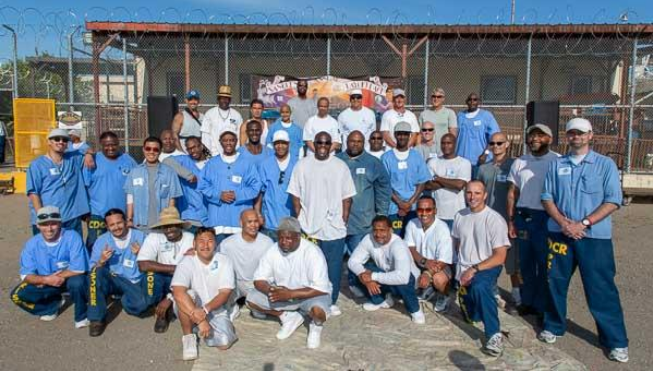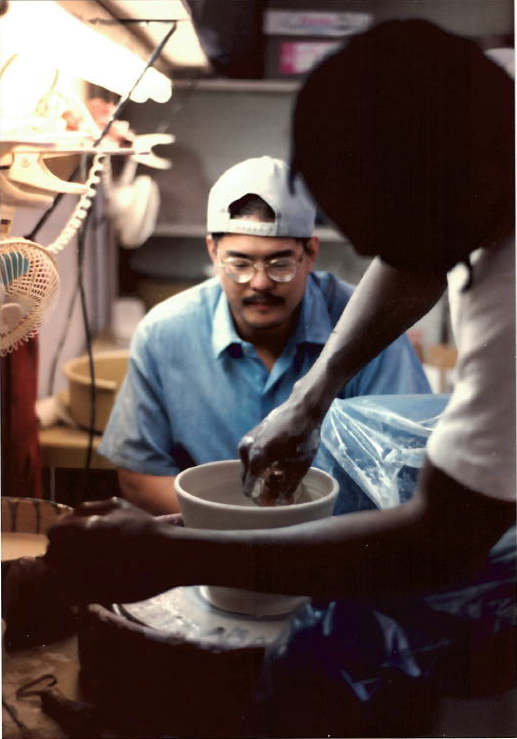Steve Emrick never sought to be a leader—but leadership found him. This is the last in a six-part series of posts based on an interview I conducted with Steve about his three decades running arts programs in California’s prison system. In Section 5, Steve described how arts in the prisons was finally reinstated, addressed critiques of arts in the prisons, and explained how he segued into his current position running all the volunteer programs at San Quentin.
Sarah: You and your family live on the grounds of San Quentin. How did that come about?
Steve: When I applied to transfer from Duel Vocational Institute in Tracy to San Quentin, I told the administrators of San Quentin I needed a house for my family. There are only 85 houses on the grounds, so only a select few get to live here. So when the administrators granted my request, I took it as an acknowledgement of the value of my work.
Sarah: What’s it like to live at San Quentin?
Steve: I think of it as Mayberry with an edge. We live on a quiet, tree-lined street, in a quaint little house that was built in 1920. The gym down the block used to be a schoolhouse. It’s strange because I don’t really engage with most of my neighbors. They think differently about political issues than our family does. But they’re friendly and treat us with respect. We’ve very close to our East Indian neighbors across the street.
I do get to see staff who I work with in a different light because they’re out mowing their lawns. And I’ve been embraced a little more by the correctional staff than I would be if I were just a commuter.
Sarah: Tell me about the “edge” part.
Steve: There’s a gun range not far from our house. You hear the officers practicing. You hear alarms. It’s pretty weird to live prison life 24 hours a day.
Mayberry with an edge.
Sarah: Do you ever feel imprisoned?
Steve: Not at the house. But I get called in a lot on weekends, like if there’s problem at the gate with a volunteer’s paperwork.
On the other hand, we live so close to beauty. I can see Mount Tam from my neighbor’s house. And living here has provided great opportunities for my family. Dana has taught at San Francisco State for years and is teaching middle school in Marin now. And my daughter has been able to attend good schools in the area.
Sarah: Do you have any regrets about paths not taken?
Steve: No. Social justice work has changed my understanding of art’s purpose. I learned that art can be a lifeline for someone. When I went through my MFA program, I got caught up in academics and art criticism. Now, I don’t care if someone in an art class can only make a terrible scribble. If they’re making it, I’m excited about it. And if they’re excited about it, I love it.
It hasn’t just changed how I feel about teaching art; it’s also changed my approach to my own art. Before, I’d gotten all stuffy. I thought I needed to have gallery exhibits and be recognized in that way. Now I just want to make things, explore, without the need for it to go anywhere in particular.
I read something about how some Native American tribes pick leaders. The person they choose as a leader isn’t the person who wants to be the leader. I can relate to that. It wasn’t my vision to be running prison art programs or do what I’m doing now. It happened through a series of missteps. But I’ve learned that I do have an ability to work with people. I’ve left a bigger footprint than if I’d had a solo art career and pieces in galleries. I can point to a guy who came from a background of doing harm, and who learned in prison to make classical guitars and still makes them. And they sell for five to 10 thousand bucks each.
Sarah: Describe your art.
Steve: I make fine-art furniture. The pieces are functional and sculptural at the same time. I primarily work in wood but I sometimes inlay stone or other materials. These are one-of-a-kind or limited-edition pieces. It’s different from traditional woodworking, which requires a certain kind of exacting work. This work is exacting too but at the same time it’s more freeform; it evolves as I work on it.
Early in my art career I worked making guitars, and a lot of my pieces are influenced by that—the bending and shaping of the wood; the finishes I use.
Hall Table (black granite and bent laminate plywood)
Writing Desk (bent and formed plywood; figured maple veneer)
Jewelry Box (dyed walnut and maple)
Sarah: What do you want to do next?
Steve: I haven’t been actively doing my art so I’m not sure how it will evolve. I do want to do pieces about my prison experience. I want to do something related to the huge, rusted iron doors and entranceways at San Quentin. They’re over 160 years old. When I leave the prison, I go through what’s called a sally port, then into a cage, through another door, and finally reach the outside. It’s always a relief to get out of the main perimeter of the prison. Inside, something could happen. Outside, I’m free to walk. I’m always thinking about the parallel between that and art. Art frees your mind. I want to make a doorway. And what would be inside would be an open cabinet, or multiple doors that would open.
Sally port.
Original metal gate.
Exit door.
I’d also like to take a printmaking class and work in two dimensions. And I contemplate writing about my experience. But that will have to wait until I’ve gotten some distance from this environment.
Sarah: Where will you live when you no longer live at San Quentin?
Steve: I’ve worked in the prisons for almost 30 years now. At some point I’d like to live closer to nature and have an art studio. I picture having a cup of coffee on the porch and not needing to be anywhere. I’m also looking forward to more family time and more travel.
Sarah: What else would you like to say?
Steve: Once I’m done with this work I’d like to have more interaction with the men I’ve worked with in the past. I’m connected with guys who are doing well, and once I’m not working for the Department of Corrections I’ll be more free to interact with them, do projects with them, and advocate for them. Beyond working with guys I know personally, I want to help support the reentry of inmates into society. I’ve spent all these years focused on helping people inside but there’s a big need for support on the outside. So I’m looking forward to that.
-
August 2021
- Aug 31, 2021 The Heart Is the Major Target—Part 9: The Teacher Role Isn't My Essence Aug 31, 2021
-
June 2021
- Jun 13, 2021 The Heart Is the Major Target—Part 8: Machines Spilling Out Teachers Jun 13, 2021
-
April 2021
- Apr 14, 2021 The Heart Is the Major Target—Part 7: A Waterfall of Inspiration Apr 14, 2021
-
February 2021
- Feb 14, 2021 The Heart Is the Major Target—Part 6: Grab the Right Computer File Feb 14, 2021
-
December 2020
- Dec 26, 2020 The Heart Is the Major Target—Part 5: Yoga Is My Second Child Dec 26, 2020
-
November 2020
- Nov 5, 2020 The Heart Is the Major Target—Part 4: Wow, This Is Me Nov 5, 2020
-
October 2020
- Oct 4, 2020 The Heart Is the Major Target—Part 3: In Exile in My Own Country Oct 4, 2020
-
August 2020
- Aug 23, 2020 The Heart Is the Major Target—Part 2: Openness to the Unseen Aug 23, 2020
- Aug 2, 2020 The Heart Is the Major Target—Part 1: Let's Move Around; We'll Feel Better Aug 2, 2020
-
July 2020
- Jul 25, 2020 Educator Wellness Series Conclusion: Moving Forward with Wellness Jul 25, 2020
- Jul 6, 2020 Educator Wellness Practice #10: Inhabiting the Dignified Stance of "Adequate" Jul 6, 2020
-
June 2020
- Jun 17, 2020 Educator Wellness Practice #9: Jun 17, 2020
- Jun 3, 2020 Educator Wellness Practice #8: Reducing Stress Through Body Scanning Jun 3, 2020
-
May 2020
- May 21, 2020 Facebook Live Event: A Conversation About the Impact of Saying Goodbye to Students May 21, 2020
- May 13, 2020 Educator Wellness Practice #7: Setting Intention and Letting Go of Results May 13, 2020
- May 6, 2020 Educator Wellness Practice #6: Practicing Goodwill as Self-Care May 6, 2020
-
April 2020
- Apr 29, 2020 Educator Wellness Practice #5: Dealing with Constant Change Apr 29, 2020
- Apr 22, 2020 Educator Wellness Practice #4: Listening to Silence Apr 22, 2020
- Apr 21, 2020 Facebook Live Event: A Conversation About the Importance of Self-Care Apr 21, 2020
- Apr 15, 2020 Educator Wellness Practice #3: Apr 15, 2020
- Apr 8, 2020 Educator Wellness Practice #2: Engaging Wisely with News and Media Apr 8, 2020
- Apr 1, 2020 Educator Wellness Practice #1: Breathe ... Keep Breathing Apr 1, 2020
-
March 2020
- Mar 25, 2020 Educator Wellness Series for Collaborative Classroom Mar 25, 2020
-
May 2019
- May 19, 2019 Managing to Build Bridges - Part 8: Do We Want to Be Right in a Dictionary Sense? May 19, 2019
-
April 2019
- Apr 27, 2019 Managing to Build Bridges - Part 7: You Just Need to Find a Good Husband Apr 27, 2019
- Apr 6, 2019 Managing to Build Bridges - Part 6: Human Remains and Cultural Artifacts Apr 6, 2019
-
March 2019
- Mar 17, 2019 Managing to Build Bridges - Part 5: Poetry Has No Rules Mar 17, 2019
- Mar 3, 2019 Managing to Build Bridges - Part 4: Dessert Goes to a Different Stomach Mar 3, 2019
-
January 2019
- Jan 13, 2019 Managing to Build Bridges - Part 3: I Felt Pretty Stupid Jan 13, 2019
-
December 2018
- Dec 9, 2018 Managing to Build Bridges - Part 2: Such a Bad Kid Dec 9, 2018
-
November 2018
- Nov 23, 2018 Managing to Build Bridges - Part 1: The Pressure to Be a Certain Type of Girl Nov 23, 2018
-
October 2018
- Oct 23, 2018 Leadership Without Ego - Part 6: Mayberry with an Edge Oct 23, 2018
- Oct 1, 2018 Leadership Without Ego - Part 5: Everyone Everywhere Deserves to Make Art Oct 1, 2018
-
September 2018
- Sep 10, 2018 Leadership Without Ego - Part 4: I'm About Ready to Swear Sep 10, 2018
-
August 2018
- Aug 19, 2018 Leadership Without Ego - Part 3: The Dalai Lama Breaks All the Rules Aug 19, 2018
-
July 2018
- Jul 29, 2018 Leadership Without Ego - Part 2: The Kids Melted Under That Praise Jul 29, 2018
- Jul 10, 2018 Leadership Without Ego - Part 1: The Workshop Was Neutral Territory Jul 10, 2018
-
May 2018
- May 26, 2018 The Alchemy of Service - Part 5: Watch Out, Someone's Behind You May 26, 2018
- May 6, 2018 The Alchemy of Service - Part 4: Fireworks and Tears May 6, 2018
- May 5, 2018 The Alchemy of Service - Part 3: Joann Wong! You Are Chinese! May 5, 2018
-
April 2018
- Apr 6, 2018 The Alchemy of Service - Part 2: Mom, It's Only a Nickel Apr 6, 2018
-
March 2018
- Mar 19, 2018 The Alchemy of Service - Part 1: Mouse Soup Mar 19, 2018
-
February 2018
- Feb 18, 2018 Back to the Garden - Part 4: Mountain Lion Footprints on the Deck Feb 18, 2018
- Feb 3, 2018 Back to the Garden - Part 3: "You're a Good Egg—Happy Easter" Feb 3, 2018
-
January 2018
- Jan 15, 2018 Back to the Garden - Part 2: "A Pretty Big Failure" Jan 15, 2018
- Jan 1, 2018 Back to the Garden - Part 1: "Aesthetic Shock" Jan 1, 2018
-
August 2017
- Aug 15, 2017 Goodbye Self-esteem, Hello Self-compassion – Part 3: Real Love Aug 15, 2017
-
July 2017
- Jul 31, 2017 Goodbye Self-esteem, Hello Self-compassion – Part 2: Mirror, Mirror Jul 31, 2017
- Jul 17, 2017 Goodbye Self-esteem, Hello Self-compassion – Part 1: Bashing Vasco Jul 17, 2017
-
May 2017
- May 28, 2017 This Thing I Found: Teens Teach Us How to See Freshly May 28, 2017
-
March 2017
- Mar 20, 2017 Dream On - Part 6: Dream Analysis Example Mar 20, 2017
- Mar 7, 2017 Dream On - Part 5: A Dream Analysis Technique (cont.) Mar 7, 2017
-
February 2017
- Feb 20, 2017 Dream On - Part 4: A Dream Analysis Technique Feb 20, 2017
-
January 2017
- Jan 22, 2017 Dream On - Part 3: Recording Dreams Jan 22, 2017
- Jan 15, 2017 Dream On - Part 2: Dream Recall Jan 15, 2017
-
December 2016
- Dec 30, 2016 Dream On – Part 1 Dec 30, 2016
- Dec 12, 2016 Enjoying the Ride of Serendipity Dec 12, 2016
- Dec 6, 2016 Agnes Martin: A Singular Career Dec 6, 2016





























